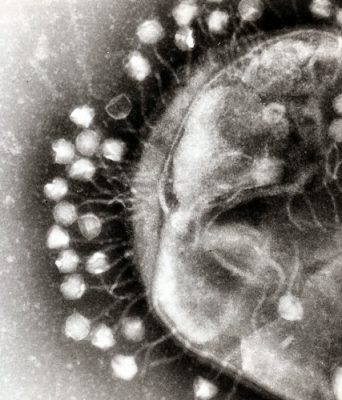Phage therapy
PDFCécile Breyton, Director of Research at the CNRS, Institut de Biologie Structurale, CEA, Université Grenoble Alpes, Grenoble

Like any virus, phages recognize their host with high specificity. Thus, a phage can only infect a defined bacterial strain. After a recognition step of surface receptors, the phage injects its DNA into the bacterial cytoplasm. It then diverts the biosynthetic machinery of its host to its own advantage to produce from ten to several hundred new virions, identical to the parent phage, released at the end of the viral cycle by the lysis of the host bacterium (lytic cycle). Some phages have the ability to integrate their DNA into the bacterial chromosome. These prophages are transmitted to daughter cells for generations (lysogenic cycle), but can wake up at any time to enter a lytic cycle. It is during the alternation of these two cycles that phages can transport bacterial DNA fragments from one bacterium to another (transduction).

In 1928, Alexander Fleming discoveres penicillin. A well-defined chemical molecule, whose production became industrial in the early 1940s. Penicillin was an immediate success, quickly relegating phage therapy to the closet (cocktails of phages were still in the “Vidal” (the French record of all drugs) until the 1970s, reimbursed by the French social security). In the Eastern Block, however, due to the impermeability of the Iron Curtain to antibiotics, phage therapy continues to be used against infections. An institute, founded in Tbilisi, Georgia in 1923 by a disciple of d’Hérelle, is dedicated to phage therapy: since then and until today, it has accumulated an expertise and a collection of phages to treat many infectious diseases, from the most benign to the most serious, especially those related to antibiotic-resistant strains.
The increasing increase in the number of antibiotic-resistant pathogenic bacterial strains and the very limited number of new antibiotics in the pipelines are bringing phage therapy back into the West. However, the regulatory constraints of drug agencies have evolved since last century: phage therapy was still not allowed a few years ago, particularly because phages still do not have a “Marketing Authorization for Drugs” for human use from the National Drug Safety Agency (a long and costly procedure). However, the legislation is slowly changing, due to: i) the pressure from an increasing number of amputations and deaths due to antibiotic-resistant infections, ii) of the opening of borders, iii) the accounts of miraculous remissions of patients who went as a last resort to Georgia for treatment with “Stalin’s forgotten cure” [6], but also thanks to the tenacity of some practitioners, notably that of Alain Dublanchet and Olivier Patey [2].
Thus, in France, since February 2016, “Temporary Use Authorizations” have been issued on a case-by-case basis, authorizing the use of phage cocktails prepared by a French start-up, Phérécydès Pharma (the use of cocktails is important to avoid the development of resistance from the target bacteria), and French newspapers are beginning to tell us the story of miraculous recovery of people suffering from osteo-articular infections in therapeutic impasse, to whom only amputation was proposed [7]. In Europe, Poland and Belgium have already been offering compassionate phage therapy treatments for several years. In the United States as well, outside of any legislation, phage therapy is offered, particularly to treat infected diabetic foot ulcers. A few cases of miraculous recovery of patients “resurrected” from deep comas have recently been reported in the press [8],[9], giving hope of breaking the therapeutic deadlock when antibiotic infections are completely recalcitrant. [10]
However, phage therapy is not the miracle cure for all infectious diseases: for example, phages must be provided at the site of the infection and cocktails of phages, specific for the pathogenic strain, must be available. However, the benefits are clear, and when used in combination with antibiotics with which there are important synergies, this ancient cure could prevent humanity from falling back into a “pre-antibiotic” era.
References and notes
[1] F. Ravat, P. Jault, J. Gabard, Bacteriophages and Phage therapy: use of natural viruses to treat bacterial infections, Ann. Burns Fire Disasters. 28 (2015) 13–20.
[2] A. Dublanchet, Des virus pour combattre les infections: la phagothérapie : renouveau d’un traitement au secours des antibiotiques. Favre, Lausanne, 2009.
[3] F. D’Herelle, R. H. Malone, A Preliminary Report of Work Carried out by the Cholera Bacteriophage Enquiry, Indian Med. Gas. 62 (1927) 614–616.
[4] S.M. Faruque, M.J. Islam, Q.S. Ahmad, A.S.G. Faruque, D.A. Sack, G.B. Nair, J.J. Mekalanos, Self-limiting nature of seasonal cholera epidemics: Role of host-mediated amplification of phage, Proc. Natl. Acad. Sci. U. S. A. 102 (2005) 6119-6124. doi:10.1073/pnas.0502069102.
[5] W.N. Kazeeff, Le bactériophage : applications thérapeutiques et prophylactiques dans les maladies infectieuses, La Nature. 3001 (1937). http://sciences.gloubik.info/spip.php?article558.
[6] R. Stone, Stone, R. Bacteriophage therapy. Stalin’s forgotten cure. Science 298, 728-731 (2002). doi:10.1126/science.298.5594.728.
[7] E. Frisullo, Comments – Lyon: How viruses in sewers treat bacterial infections, (2017). https://www.20minutes.fr/article/2136243/commentaires/1.
[8] Mr. Shen, “You become desperate”: Obscure therapy saves woman’s life, KOMO. (2013). http://komonews.com/news/healthworks/you-become-desperate-obscure-therapy-saves-womans-life.
[9] U.S. patient with drug-resistant bacterial infection saved by phage therapy: report | CTV News, (2017). https://www.ctvnews.ca/health/u-s-patient-with-drug-resistant-bacterial-infection-saved-by-phage-therapy-report-1.3391210.
[10] The European Phagoburn project, involving 4 SMEs and 11 clinical laboratories, is nearing completion. This is the first prospective multicenter, randomized, blind, controlled, single-blind, prospective phage therapy clinical trial conducted under both good manufacturing practices and good clinical practices to evaluate phage therapy for the treatment of bacterial skin infections in severe burn victims (http://www.phagoburn.eu). The results obtained should lead to significant progress in the regulatory framework for phage therapy in Europe. Indeed, the presence of a precise framework is important so that errors made with antibiotics are not repeated.
For more information:
Our enemy’s enemy: bacteriophage viral medicine. “Planète de virus” – Carl Zimmer – Editions Belin (Paris 2016)




